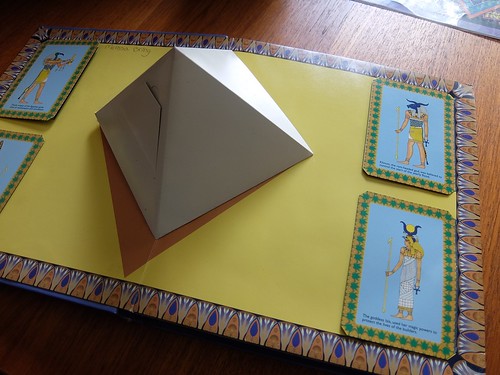There's still some ambiguity, one could say by design, in what Pyramid means, even just as a shape, never mind as an artifact.
The artifact provides the default meaning: square base, for five facets in all (base + four sides).
However in mathematics texts we learn of the n-sided pyramid, meaning a triangular base as a lower limit, and no upper limit on how many uniform sides, to approach a perfect circle, a cone.
We have a special name for the hexahedron of all equal angles and edge lengths: the cube. We might say "simplex" for tetrahedron if we want to sound savvy, but that still might not mean regular. "Regular tetrahedron" takes a long time to say and write.
One of our andra- / peda- gogical devices is the book with triangular covers, open flat, with a single triangular page flapping back and forth, a stiff flap, its tip arcing through 180 degrees (or pi radians) to define complementary tetrahedra.
David Koski and I put some of the math in the cloud as open source, in the liberal tradition of academic sharing. The only unusual aspect of this exhibit is the option to measure in regular tetrahedron units, when tabulating volumes. Also, Quadrays get used in the unit tests.
Today I was working with an elementary school math teacher / tutor on the Pythagorean Theorem and its ramifications, which dovetailed nicely with my work with the @property decorator in Python.
The artifact provides the default meaning: square base, for five facets in all (base + four sides).
However in mathematics texts we learn of the n-sided pyramid, meaning a triangular base as a lower limit, and no upper limit on how many uniform sides, to approach a perfect circle, a cone.
We have a special name for the hexahedron of all equal angles and edge lengths: the cube. We might say "simplex" for tetrahedron if we want to sound savvy, but that still might not mean regular. "Regular tetrahedron" takes a long time to say and write.
One of our andra- / peda- gogical devices is the book with triangular covers, open flat, with a single triangular page flapping back and forth, a stiff flap, its tip arcing through 180 degrees (or pi radians) to define complementary tetrahedra.
David Koski and I put some of the math in the cloud as open source, in the liberal tradition of academic sharing. The only unusual aspect of this exhibit is the option to measure in regular tetrahedron units, when tabulating volumes. Also, Quadrays get used in the unit tests.
Today I was working with an elementary school math teacher / tutor on the Pythagorean Theorem and its ramifications, which dovetailed nicely with my work with the @property decorator in Python.


